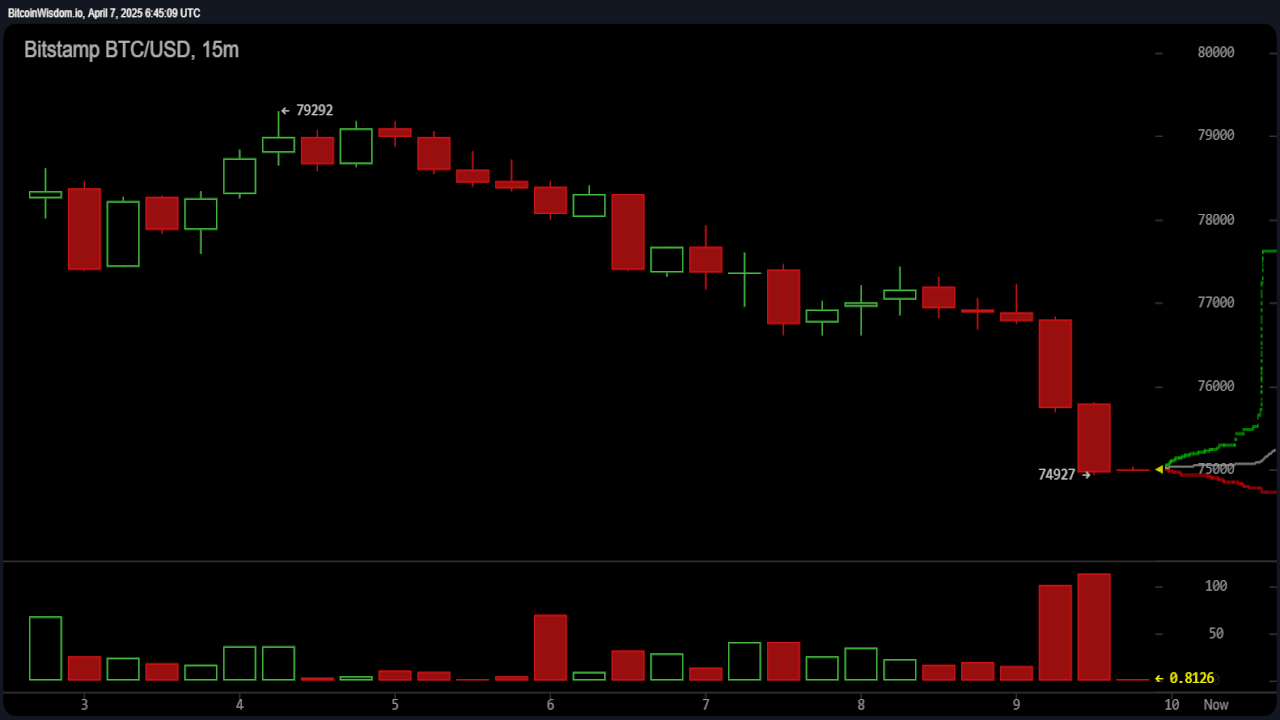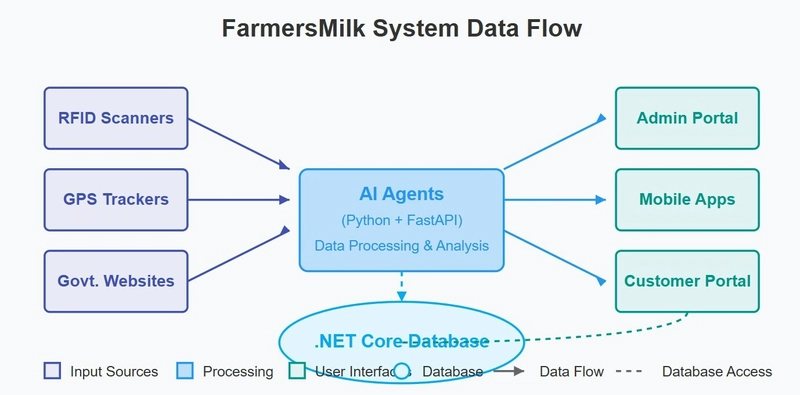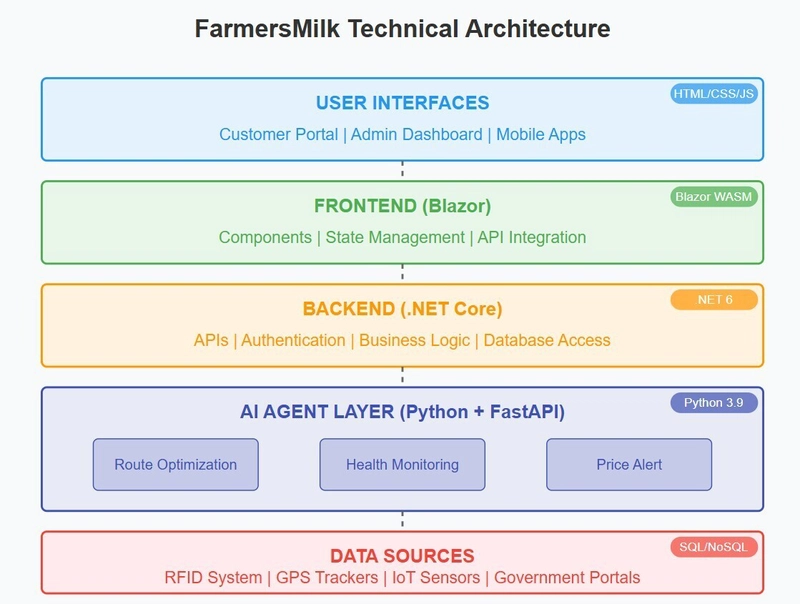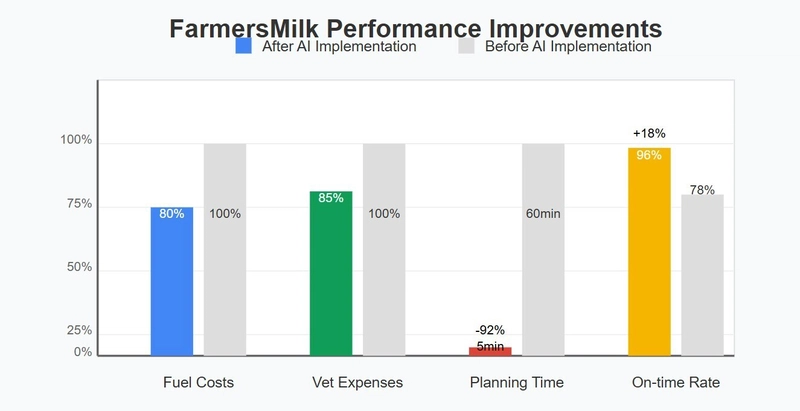Building an Intelligent AI System for Dairy Farm Management: The FarmersMilk Story
The AI systems I developed for FarmersMilk, a dairy tech platform combining .NET, Blazor, Python, FastAPI, and AI agents to transform traditional farm operations. This real-world implementation demonstrates my ability to design scalable, intelligent systems for rural agritech. As the sole architect and developer, I conceptualized and implemented every component of this system, from hardware integration to AI agent design. When I began developing FarmersMilk, I had a straightforward goal: to digitize operations for our family dairy farm in India. I soon realized this project required more than basic digital tools—it needed intelligent systems that could analyze, predict, and take action, similar to how an experienced farm manager would. This journey from a simple digital system to a network of AI agents taught me valuable lessons about practical AI implementation. Today, I'll share how we transformed traditional dairy farming operations using accessible technology and thoughtful architecture design. Moving Beyond Traditional Systems Conventional dairy management software typically offers static functionality—data input and reporting. However, farming is dynamic, with daily changes in delivery routes, milk production, and animal health. I needed a more responsive solution. The gap between traditional systems and our needs: Traditional Systems Our Requirements Periodic reports Real-time insights Manual decision-making Automated actions Fixed workflows Adaptive processes Data collection focus Action-oriented intelligence My approach was to create AI agents that work continuously to make decisions in the background—transforming passive data collection into active farm management. Team-Based Architecture I developed a hierarchical structure inspired by enterprise systems: • A Super-Agent coordinates overall operations • Specialized Sub-agents handle specific functions: o Route optimization o Animal health monitoring o Government milk price alerts o Weather prediction (in development) Each agent monitors, processes, and acts on real-time farm data. "FarmersMilk AI Agent Architecture : Hierarchical AI agent architecture showing the Super-Agent coordinating specialized sub-agents for route optimization, health monitoring, and price alerts" This architectural design follows a key principle: each agent should excel at a specific task rather than building one complex system trying to do everything. The modularity allows us to add new agents or modify existing ones without disrupting the entire system. Route Optimization Agent Delivering milk to over 50 homes daily in rural areas presented logistical challenges. I developed this agent using Python and Google OR-Tools to calculate the most efficient delivery routes based on GPS locations, time requirements, and fuel costs: Python Code from ortools.constraint_solver import routing_enums_pb2 from ortools.constraint_solver import pywrapcp def optimize_route(locations): # Define the routing index manager manager = pywrapcp.RoutingIndexManager(len(locations), 1, 0) routing = pywrapcp.RoutingModel(manager) # Cost function goes here... solution = routing.SolveWithParameters(search_parameters) return extract_routes(solution) This implementation resulted in a 20% reduction in fuel consumption and improved on-time delivery performance, even to remote locations. Health Monitoring Agent Buffalo health issues aren't always immediately apparent. However, their milk production, feeding patterns, and movement data (tracked via RFID) provide valuable indicators. I trained a machine learning model with TensorFlow to identify potential health concerns before visible symptoms appear: Python Code def monitor_buffalo(milk_data, feeding_pattern): model = tf.keras.models.load_model('buffalo_health_model.h5') result = model.predict([milk_data, feeding_pattern]) if result == 'Risk': alert_vet() This proactive approach allows us to address health issues earlier, reducing treatment expenses and minimizing production losses. Milk Price Alert Agent Government regulations in India cause frequent changes in milk prices. This agent automatically checks the official government website each morning for price updates: Python Code def check_price_update(): latest_price = scrape_government_portal() if latest_price != cached_price: notify_admins() update_price_in_system(latest_price) When changes occur, it sends notifications to administrators, distributors, and customers through our application. Technical Integration All AI agents operate as FastAPI microservices written in Python. Our customer portal and delivery dashboards, built with Blazor, communicate with these services via HTTP requests, creating a seamless connection between our .NET Core backend and Python-based AI components: C# Code [HttpGet("api/

The AI systems I developed for FarmersMilk, a dairy tech platform combining .NET, Blazor, Python, FastAPI, and AI agents to transform traditional farm operations. This real-world implementation demonstrates my ability to design scalable, intelligent systems for rural agritech. As the sole architect and developer, I conceptualized and implemented every component of this system, from hardware integration to AI agent design.
When I began developing FarmersMilk, I had a straightforward goal: to digitize operations for our family dairy farm in India. I soon realized this project required more than basic digital tools—it needed intelligent systems that could analyze, predict, and take action, similar to how an experienced farm manager would.
This journey from a simple digital system to a network of AI agents taught me valuable lessons about practical AI implementation. Today, I'll share how we transformed traditional dairy farming operations using accessible technology and thoughtful architecture design.
Moving Beyond Traditional Systems
Conventional dairy management software typically offers static functionality—data input and reporting. However, farming is dynamic, with daily changes in delivery routes, milk production, and animal health. I needed a more responsive solution.
The gap between traditional systems and our needs:
Traditional Systems Our Requirements
Periodic reports Real-time insights
Manual decision-making Automated actions
Fixed workflows Adaptive processes
Data collection focus Action-oriented intelligence
My approach was to create AI agents that work continuously to make decisions in the background—transforming passive data collection into active farm management.
Team-Based Architecture
I developed a hierarchical structure inspired by enterprise systems:
• A Super-Agent coordinates overall operations
• Specialized Sub-agents handle specific functions:
o Route optimization
o Animal health monitoring
o Government milk price alerts
o Weather prediction (in development)
Each agent monitors, processes, and acts on real-time farm data.
"FarmersMilk AI Agent Architecture : Hierarchical AI agent architecture showing the Super-Agent coordinating specialized sub-agents for route optimization, health monitoring, and price alerts"
This architectural design follows a key principle: each agent should excel at a specific task rather than building one complex system trying to do everything. The modularity allows us to add new agents or modify existing ones without disrupting the entire system.
Route Optimization Agent
Delivering milk to over 50 homes daily in rural areas presented logistical challenges.
I developed this agent using Python and Google OR-Tools to calculate the most efficient delivery routes based on GPS locations, time requirements, and fuel costs:
Python Code
from ortools.constraint_solver import routing_enums_pb2
from ortools.constraint_solver import pywrapcp
def optimize_route(locations):
# Define the routing index manager
manager = pywrapcp.RoutingIndexManager(len(locations), 1, 0)
routing = pywrapcp.RoutingModel(manager)
# Cost function goes here...
solution = routing.SolveWithParameters(search_parameters)
return extract_routes(solution)
This implementation resulted in a 20% reduction in fuel consumption and improved on-time delivery performance, even to remote locations.
Health Monitoring Agent
Buffalo health issues aren't always immediately apparent. However, their milk production, feeding patterns, and movement data (tracked via RFID) provide valuable indicators.
I trained a machine learning model with TensorFlow to identify potential health concerns before visible symptoms appear:
Python Code
def monitor_buffalo(milk_data, feeding_pattern):
model = tf.keras.models.load_model('buffalo_health_model.h5')
result = model.predict([milk_data, feeding_pattern])
if result == 'Risk':
alert_vet()
This proactive approach allows us to address health issues earlier, reducing treatment expenses and minimizing production losses.
Milk Price Alert Agent
Government regulations in India cause frequent changes in milk prices.
This agent automatically checks the official government website each morning for price updates:
Python Code
def check_price_update():
latest_price = scrape_government_portal()
if latest_price != cached_price:
notify_admins()
update_price_in_system(latest_price)
When changes occur, it sends notifications to administrators, distributors, and customers through our application.
Technical Integration
All AI agents operate as FastAPI microservices written in Python.
Our customer portal and delivery dashboards, built with Blazor, communicate with these services via HTTP requests, creating a seamless connection between our .NET Core backend and Python-based AI components:
C# Code
[HttpGet("api/route/optimize")]
public async Task OptimizeRoute()
{
var response = await _httpClient.GetAsync("http://ai-agent-api/route");
var route = await response.Content.ReadFromJsonAsync();
return Ok(route);
}
This integration bridges .NET Core, Python, and AI into one cohesive system.
"FarmersMilk System Data Flow: Data flowing from input sources (RFID, GPS, government websites) through AI processing to user interfaces, with database connections indicated."
System Architecture
As the sole architect and developer of FarmersMilk, I designed and implemented every component of the system—from frontend dashboards and backend services to AI microservices and integrations with RFID hardware and IoT sensors. This comprehensive approach allowed me to ensure seamless operation across all layers.
"FarmersMilk Technical Architecture: This layered system architecture with User Interface Layer at the top, followed by Frontend Layer, Backend Layer, AI Agent Layer, and Data Source Layer at the bottom. This technical architecture shows the five-layer approach from user interfaces to data sources"
The complete architecture follows a layered approach:
1.User Interface Layer: Blazor-based responsive interfaces for
customers, administrators, and delivery personnel.
2.Frontend Layer: Component-based design with efficient state
management and API integrations.
3.Backend Layer: .NET Core APIs handling authentication, business
logic, and database operations.
4.AI Agent Layer: Python-based intelligent agents deployed as FastAPI
microservices.
5.Data Source Layer: Physical hardware (RFID, GPS, IoT) and external
data sources (government portals).
This architecture enables both vertical scaling (adding more resources to existing components) and horizontal scaling (adding new agents or capabilities) as the system grows.
Future Developments
I'm currently working on additional agents to further enhance our farm operations:
• **Climate-based Yield Predictor:** Using temperature and humidity
data to forecast production levels, this agent will help us plan
inventory and staffing needs 7-14 days in advance.
• **Customer Satisfaction Analyzer:** By processing delivery feedback
and scanning patterns, this agent will identify potential service
issues before they lead to customer churn.
•**Animal Stress Detector:** Leveraging IoT sensors that monitor
buffalo movement patterns and ambient conditions, this agent will
detect early signs of stress that could affect animal welfare and
production.
What makes these new agents exciting is how they'll interact with our existing system, creating a more comprehensive intelligence network that addresses both operational and strategic needs.
Real-World Impact
The implementation of our AI agent system has delivered tangible benefits:
•**Cost Reduction:** 20% decrease in fuel costs and 15% reduction in
veterinary expenses
• **Time Savings:** Delivery planning reduced from 1 hour to 5
minutes daily
• **Quality Improvement:** Early health intervention has improved
milk quality metrics
• **Customer Satisfaction:** On-time delivery rate increased from 78%
to 96%
"FarmersMilk Performance Metrics: Performance improvements after AI implementation showing significant reductions in costs and time with increased delivery reliability"
What makes these improvements significant is that they were achieved without expensive enterprise software or complex infrastructure—just smart application of accessible tools and focused AI solutions.
Conclusion
Effective AI solutions don't require massive scale or complex infrastructure. Even small operations like our farm can benefit from targeted, efficient agents that address specific challenges.
The key lessons from building FarmersMilk:
1.Start small and focused: Build agents that solve one problem
extremely well.
2.Use available tools: Combine existing technologies rather than
building everything from scratch.
3.Measure real impact: Focus on metrics that directly affect your
operations.
4.Design for growth: Create modular systems that can evolve with your
needs.
With FarmersMilk, I'm creating technology that goes beyond data collection to take meaningful action in farm management—proving that with the right approach, AI can transform even traditional industries like agriculture.
Related Articles
•How I Built an AI-Powered Milk Delivery System – Hashnode
•Blazor + AI: My Dairy Farm Platform – Medium
•Route Optimization with Python and .NET – Dev.to
This article is also published on Medium, Dev.to, and Hashnode.









































































































































































![[The AI Show Episode 142]: ChatGPT’s New Image Generator, Studio Ghibli Craze and Backlash, Gemini 2.5, OpenAI Academy, 4o Updates, Vibe Marketing & xAI Acquires X](https://www.marketingaiinstitute.com/hubfs/ep%20142%20cover.png)

















































































































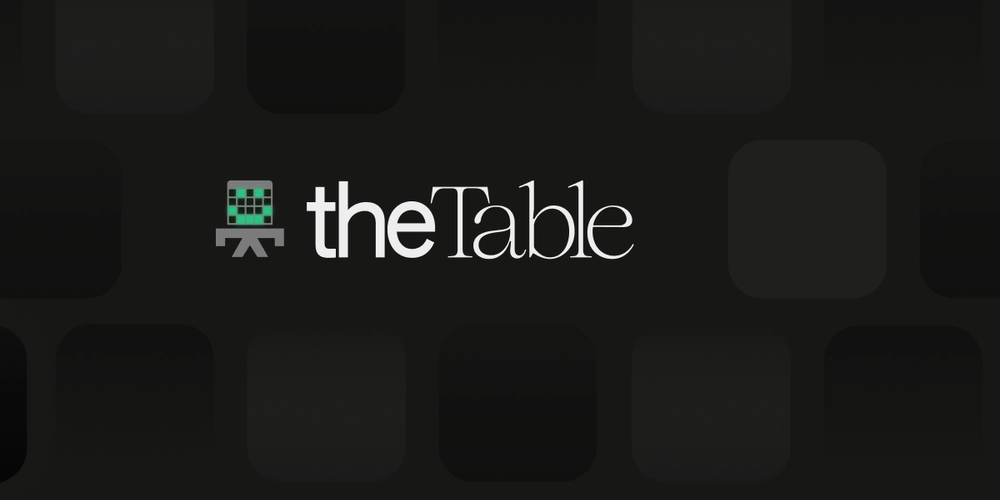
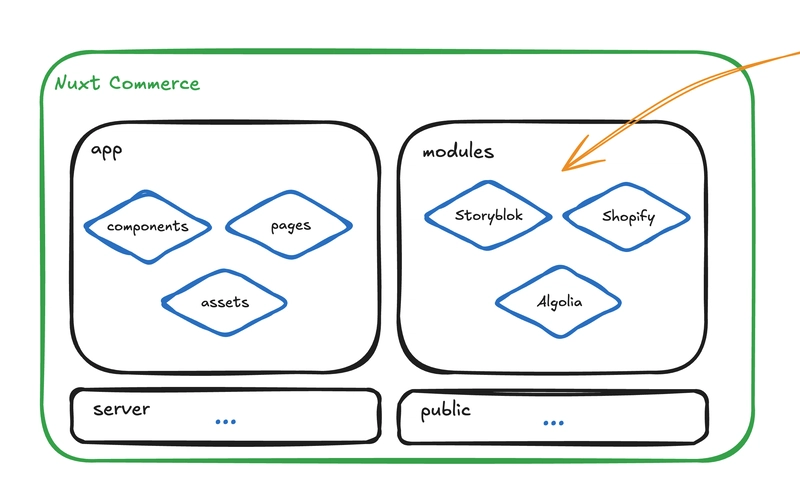
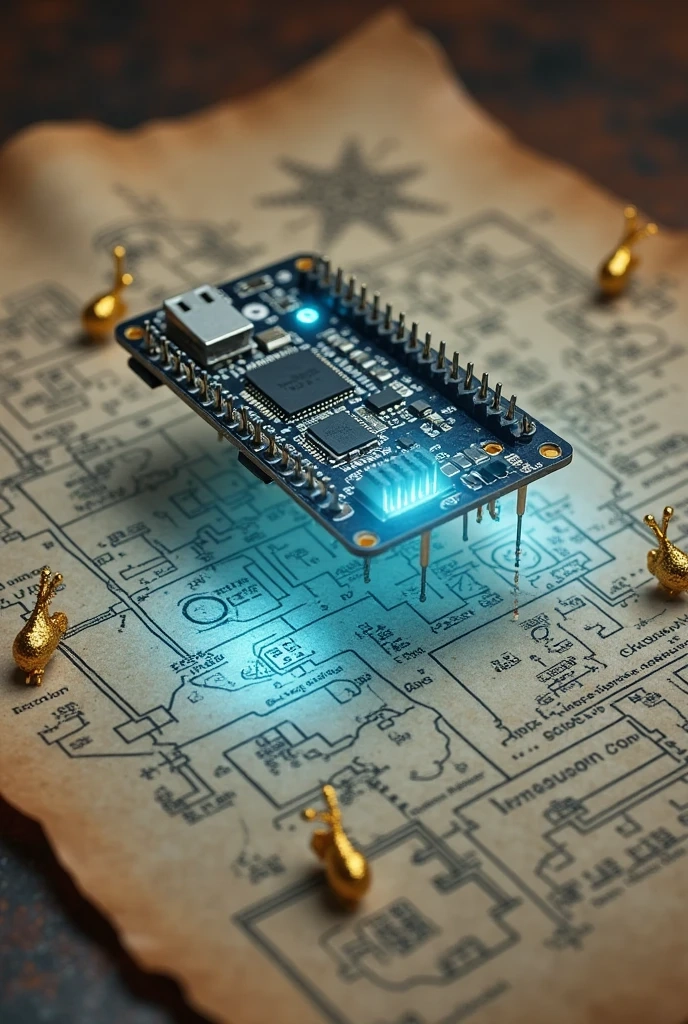











![[DEALS] The Premium Learn to Code Certification Bundle (97% off) & Other Deals Up To 98% Off – Offers End Soon!](https://www.javacodegeeks.com/wp-content/uploads/2012/12/jcg-logo.jpg)

![From drop-out to software architect with Jason Lengstorf [Podcast #167]](https://cdn.hashnode.com/res/hashnode/image/upload/v1743796461357/f3d19cd7-e6f5-4d7c-8bfc-eb974bc8da68.png?#)








































































































.png?#)


































_Christophe_Coat_Alamy.jpg?#)



.webp?#)






































































































![Apple Considers Delaying Smart Home Hub Until 2026 [Gurman]](https://www.iclarified.com/images/news/96946/96946/96946-640.jpg)
![iPhone 17 Pro Won't Feature Two-Toned Back [Gurman]](https://www.iclarified.com/images/news/96944/96944/96944-640.jpg)
![Tariffs Threaten Apple's $999 iPhone Price Point in the U.S. [Gurman]](https://www.iclarified.com/images/news/96943/96943/96943-640.jpg)


































































































